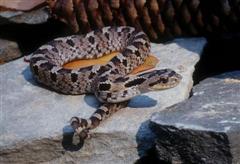Hognose - eastern
Scientific Name: Heterodon platyrhinos
Thu, 17th April, 2025 - 7:49 am GMT
Sponsor Ads:

Alternative Name
Scientific Name: Heterodon platyrhinosBasic Info
The Eastern Hognose reaches a size of 20 to 45 inches at maturity. Their bodies are stout, with a yellow to beige color, with dark brown or black spots. Towards the tail, these spots turn into rings. Some specimens are a solid color, with a black, gray or olive color. The labials are a light color. Eastern Hognoses have an upturned snout, which is where they get their name.
Health
The Eastern Hognose is sometimes considered a difficult feeder. Many require small amphibians and reptiles, such as toads and lizards, and will not eat rodents. Some Eastern Hognose can also be fed fish. Young captive bred Eastern Hognose do very well on a mixed diet of small amphibians-including small toads, small frogs, small woodland salamanders (Red Backed are preferred), freshwater fish such as minnows, or fresh fillet of catfish and trout, and occasionally pink mice or rats. The diet should always be mixed. We have found that many hatchlings that are hard to start feeding accept slices of fish fillet. Things to avoid are all foreign amphibians, all saltwater fish such as tuna, avoid goldfish and smelt also, and large brightly colored salamanders such as Spotted and Slimy Salamanders. It has been reported that Eastern Hognose snakes do not do well on diets that consists of only rodents. Breeding The Eastern Hognose breeds primarily in the spring. Gestation is two to three months. The female will lay up to 35 eggs, ten to twenty centimeters below the surface. The eggs will hatch in roughly two months. Juveniles are five to twelve inches as hatchlings, and are much brighter than adults.Habitat
They are found in wooded areas, grasslands, prairies, and by lakes. They prefer loose sandy soil. They are usually found under a rock or piece of wood.Behavior
The Eastern Hognose snakes are popular for their easy temperament, fairly small size, and coloring. They are also known for their acting abilities. The Eastern Hognose is a rear fanged, mildly venomous, snake. They rarely bite, even in self-defense. In fact, they have a special defense mechanism, playing dead. If the Eastern Hognose is threatened, it will coil up and fan its head, which makes it look like a cobra. It proceeds to hit and jab with its neck, but it normally won't bite. If these actions do not ward off the threat, the Eastern Hognose will pretend to be in pain, and will roll onto its back. It effectively plays dead. Its mouth will be open throughout the act. To prevent swallowing dirt, there is a lining in the back of the snakes mouth that seals its esophagus, and extra saliva is produced. The Eastern Hognose will continue the act until it feels it is safe. When kept in captivity, the Eastern Hognose will stop acting after a few times. In captivity the Eastern Hognoses should be kept in medium to large habitats with a deep, loose, and sandy substrate. Some vegetation should be included. They use their noses to burrow into the sand, making their homes underground. The Eastern Hognose likes to move frequently, making new homes.Origin
North AmericaHistory
Eastern Hognose Snakes, or Heterodon platirhinos, can be found in the Northeastern United States, as well as Southern Canada.Common Foods
N/ASponsor Ads:
"On the day that you take up your command, block the frontier passes, destroy the official tallies, and stop the passage of all emissaries." -- Sun Tzu, The Art of War
Hognose - eastern
Coded by: BGID® | ALL RIGHTS RESERVED Copyright © 2000-2025
Disclaimer | Privacy | Report Errors / Contact | Credits


 Preparing For China. China is growing their military. China Military Technology - can it keep up with the US?
Preparing For China. China is growing their military. China Military Technology - can it keep up with the US?  versus
versus 

 versus
versus 
 This Thread is about the North Korean Military itself - the kind of army, navy, and air force they have.
This Thread is about the North Korean Military itself - the kind of army, navy, and air force they have. 
 versus
versus 
 versus
versus  versus
versus